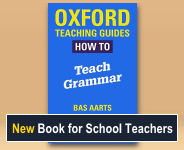Topic: Relative clause
In this topic we look at the relative clause: a special kind of subordinate clause which typically relates back to a preceding noun and gives more information about it. An example is I met a Chinese guy who was studying medicine.
Englicious contains many resources for English language in schools, but the vast majority of them require you to register and log in first. For more information, see What is Englicious?

